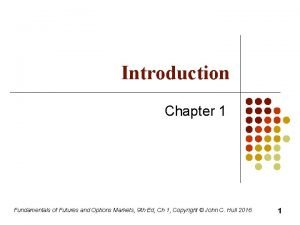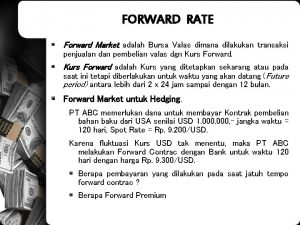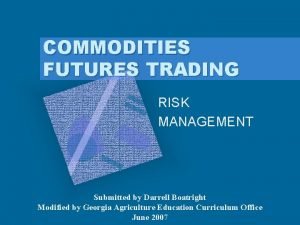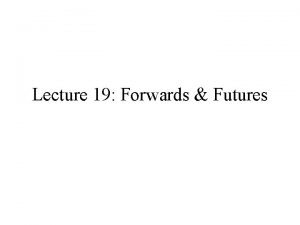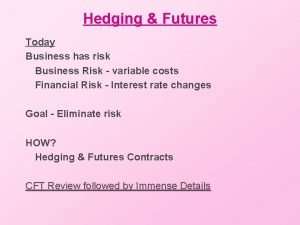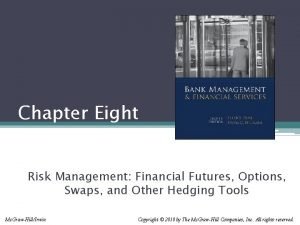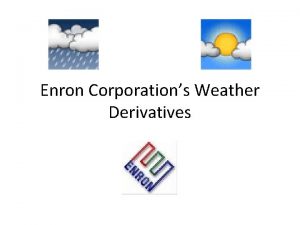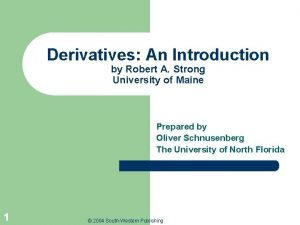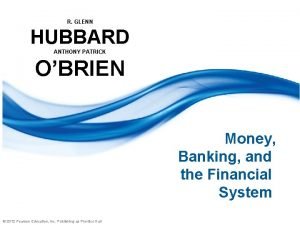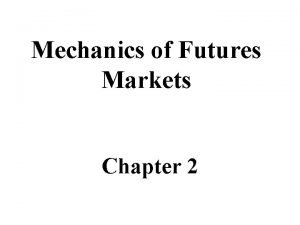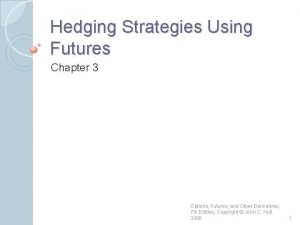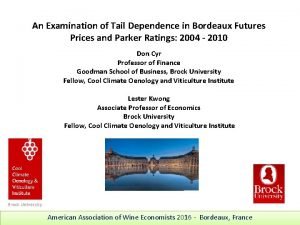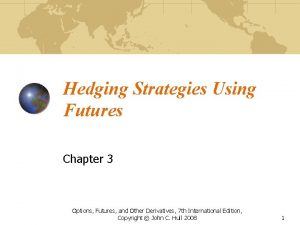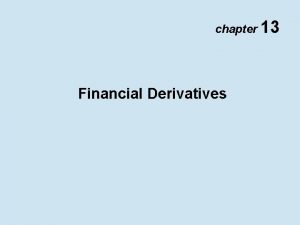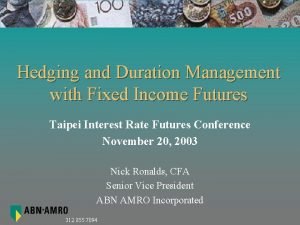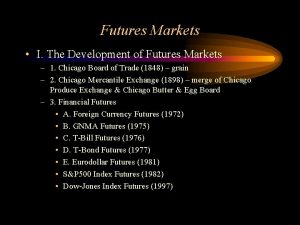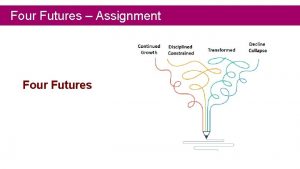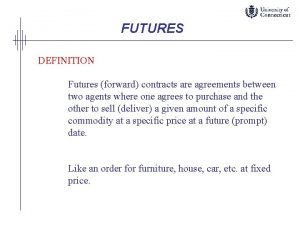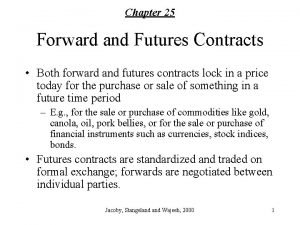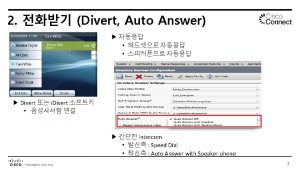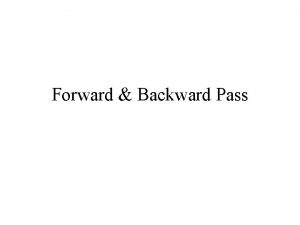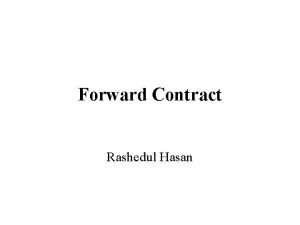Futures Topic 10 I Futures Markets A Forward
















































- Slides: 48

Futures Topic 10 I. Futures Markets

A. Forward vs. Futures Markets u 1. Forward contracting involves a contract initiated at one time and performance in accordance with the terms of the contract occurring at a subsequent time. – Example: A highly prized St. Bernard has just given birth to a litter of pups. A buyer agrees to buy one pup for $400. The exchange cannot take place for 6 weeks. The buyer and seller agree to exchange (sell) the pup in 6 weeks for $400. This is a forward contract; both parties are obligated to go through with the deal.

A. Forward vs. Futures Markets (continued) u 2. Differences b/w Forward and Futures Markets – a. The Organized Exchange – b. Contract Terms--standardized item – c. The Clearinghouse--takes no active position in the market, but interposes itself between all parties to every transaction. The number of contracts bought must always equal the number of contracts sold.

A. Forward vs. Futures Markets (continued) – d. The Requirement for Daily Resettlement FAssume that the contract closes on May 2 at 168¢/bushel. This means that A has sustained a loss of 3¢. Since there are 5000 bu. in the contract this represents a loss of $150. This amount is deducted from the margin deposited with the broker.

A. Forward vs. Futures Markets (continued) FAssume initial margin was $1400 and maintenance margin is $1100. A has already sustained a loss of $150 so the value of the margin account is $1250. If the price drops by 4¢ the following day another $200 loss is registered. The value of the margin account is down to $1050, below the maintenance margin. This means A will be required to bring the margin account back to $1400.

Table 1 u Futures Market Obligations. The oat contract is traded by the CBT. Each contract is for 5000 bushels, and prices quoted in cents per bushel.

Table 1 (continued) A May 1: Buys 1 Sept. contract for oats at 171 cents/bushel B Sells 1 Sept. contract for oats at 171 cents/bushel A Buys 1 Sept. contract for oats at 171 cents/bushel Clearinghouse Agrees to deliver to A a Sept. 1 contract for oats at 171 cents/bushel B Sells 1 Sept. contract for oats at 171 cents/bushel Clearinghouse Agrees to receive from B a 1 Sept. contract for oats at 171 cents/bushel

Table 1 (continued) u 3. A Reversing Trade--brings a trader’s net position in some futures contract back to zero. Without a reversing trade the investor will be required to either deliver the product at the contract price (if the contract was sold), or purchase the product (if the contract was purchased).

B. Purposes of Futures Markets – Meets the needs of three groups of futures market users: F 1. Those who wish to discover information about future prices of commodities (suppliers) F 2. Those who wish to speculate (speculators) F 3. Those who wish to transfer risk to some other party (hedgers)

C. Taxation of Futures Contracts u. All paper gains and losses on futures positions must be treated as though they were realized at the end of the tax year. The IRS must get it’s due on an annual basis.

Futures Topic 10 II. Futures Markets

A. Reading Futures Prices (Contracts) – 1. – 2. – 3. – 4. – 5. The Product The Exchange Size of the Contract Method of Valuing Contract The delivery month

A. Reading Futures Prices (Prices) – 1. Opening – 2. High – 3. Low – 4. Settlement--Price at which the contracts are settled at the close of trading for the day. Typically the last trading price for the day.

B. The Basis u. . . is the current cash price of a particular commodity minus the price of a futures contract for the same commodity. u BASIS = CURRENT CASH PRICE - FP

B. The Basis (continued) u Example: Gold Prices and the Basis: 12/16/92 Basis Cash DEC MAR ‘ 96 JUN SEP DEC MAR ‘ 97 $441. 50 449. 20 459. 40 469. 90 480. 70 491. 80 . 50 - $7. 70 -$17. 90 -$28. 40 -$39. 20 -$50. 30

B. The Basis (continued) Prices Cash Basis Present Futures Maturity Time

B. The Basis (continued) u 1. Relation between Cash & Futures u 2. Spreads – The difference between two futures prices (same type of contract) at two different points in time.

Futures Topic 10 III. Trading Commodities

A. Margin u. Sometimes called the deposit, it represents security to cover any loss in the market value of the contract that may result from adverse price changes. This is the cost of trading in the futures market.

B. Speculating u Assume a speculator buys a JUNE contract at $459. 40 by depositing the required margin of $3, 500. u One gold contract = 100 troy ounces, it has a market value of $45, 940. u Hence margin is: $3, 500/45, 940 = 7. 62%

B. Speculating (continued) u 1. If Gold contract goes up to $500/ounce by May, then: – Profit = $500 - $459. 40 = $40. 60 * 100 – Return = $4060/$3500 = 116% u 2. If Gold contract goes down to $410. 00/ounce by May, then: – Profit = $410 - $459. 40 = - 49. 40 * 100 - 4940/3500 = -1. 41 or – Return = 141%

B. Speculating (continued) u 3. Assume the speculator shorts by selling the JUNE contract. If price decreases then: – Receives: (459. 40 - 410) = 49. 40 * 100 – Profit: 4940 – Return: 4940/3500 = +141%

C. Spreading u. Combining two or more different contracts into one investment position that offers the potential for generating a modest profit.

C. Spreading (continued) u Ex: Buy 1 Corn contract at 258 – Sell (short) 1 Corn contract at 270 – Close out by: F 1. Selling the long contract at 264. F 2. Buy a short contract at 273. – Profit: F Long: 264 -258 = 6¢ F Short: 270 -273 = - 3¢ F 3¢ * 5000 bu = $150 Net

D. Hedging u. . . is an attempt to protect a position in a commodity. – Example: Suppose a manufacturer uses platinum as a basic raw material in the production of catalytic converters. – Assume: Platinum sells for $180/ounce today. By years end the price is expected to increase substantially.

Hedging Example (continued) – 1. Producer buys Platinum futures at $205. Assume spot price increases in 8 months to $280/ounce. And the price of the contract has increased to $325/ounce. One contract represents 50 ounces. – 2. Profit: F a. In the contract: F $325 - $205 = $120 * 50 = $6000 F b. In the spot market: F $280 - $180 = $100 * 50 = ($5000)

Hedging Example (continued) u The producer would have experienced a $5000 additional cost if he did not buy futures contracts. The net result of this hedge is that the producer has eliminated the potential loss in profits by buying the futures contract: In essence the producer has actually netted $1000.

Futures Topic 10 IV. Financial Futures

A. Assets u 1. Foreign currencies u 2. Interest Rates u 3. Stocks

B. Markets u 1. Foreign Currencies – a. British Pound – b. German Mark – c. Swiss Franc – d. Canadian Dollar – e. Mexican Peso – f. Japanese Yen – g. Dutch Guilder – h. French Franc

B. Markets (continued) u 2. Interest Rates – a. 90 -day T-bills – b. 1 -Year T-bills – c. 90 -day Bank CD’s – d. 90 -day Eurodollar Deposits – e. GNMA pass thru Certificates – f. US Treasury Notes – g. US Treasury Bonds

B. Markets (continued) u 3. Stock Index Futures – a. – b. – c. S & P Stock Index NYSE Composite Stock Index Value Line Composite

C. Contract Specifications u 1. On currencies, contracts entitle holders to claim on a certain amount of foreign currency.

C. Contract Specifications (continued) u Examples – Foreign Currencies: F 25, 000£ British F 12, 500, 000 Japanese Yen – Financial Future: F $100, 000 GNMA & T-Bonds F $1, 000 T-Bills – Stock Futures: F CASH

D. Financial Futures Relationship with Interest Rates u 1. Long Position--involves the purchase of a futures contract and the expectation that interest rates will fall. When the futures contract is purchased the underlying securities will increase in value when interest rates fall. Therefore, the value of the futures contract will increase.

D. Financial Futures Relationship with Interest Rates u Example: December T-Bonds Futures price is 67 -17. This translates to a value of 67 17/32% or. 6753125 or an underlying value of $67, 531. 25. – If interest rates go up then the value of the futures contract will decrease. – If interest rates go down the value of the futures contract will increase.

u 2. E. Financial Futures Relationship with Interest Rates Short Position--involves the sale of a futures contract and the expectation that interest rates will increase. When interest rates increase, then the underlying assets will decrease in value and the contract will also decrease in value. This enables you to purchase a contract (reverse trade) at a lower price than you sold it for.

E. Financial Futures Relationship with Interest Rates u Example: Assume you buy a December contract at 67 -17 and interest rates increase, thus resulting in a lower contract price, say down to 60 -00. – Loss = 7 17/32% * $100, 000 = - $7, 531. 25 If you sold the contract originally, (short) you would have experienced a gain if interest rates increased. u Assume the same situation, then the short gain is: 7 17/32% * $100, 000 = +$7, 531. 25

F. Hedging with Futures u Using Futures Contracts to Hedge Against Increasing Interest Rates – 1. Assume interest rates increase over a six month period of March 1 to August from 11% to 13% as measured by the prime rate. – 2. Assume a Developer takes out a construction loan of $50 million at prime + 2 points for six months.

F. Hedging with Futures (continued) u 3. To hedge the loan the Hedge Position is determined by: F $50, 000/100, 000 = 500 futures contracts = 1: 1 Hedge u 4. At a price of 67 -17 for December contracts the total value would be: F $67, 531. 25/contract * 500 = $33, 765, 625 u But the total cost to control these assets is margin/contract times 500. F$2000 * 500 = $1, 000

F. Hedging with Futures (continued) u 5. Assume on August 31, a developer “reverses” or closes his position by buying back December futures contracts at 65 -05. The lower price is due to increased interest rates. – Profits: F (67 -17) - (65 -05) = 2 -12 or 2 12/32% F. 02375 * $100, 000 = $2, 375/contract F or $1, 187, 500 for 500 contracts

F. Hedging with Futures (continued) u 6. A “Do-Nothing” strategy would have resulted in $370, 558 interest (additional) due to the rising rates. u 7. Therefore, the net hedge position would result in a total gain of $816, 942 i. e. ($1, 187, 500 - $370, 558)

F. Hedging with Futures (continued) u 8. Hence, in this case a perfect hedge could have been achieved at a hedge ratio of: – 1 to. 312 [ 156/500 ] rather than 1 to 1 $370, 558/2, 375 = 156

u 1. G. Futures Options Relationship with Interest Rates Since the futures option represents a call (right to buy a futures contract at a specific price) or a put (right to sell a futures contract at a specific price) then: – Call: decreases in value when the interest rates increase because the underlying futures asset is decreasing in value. – Put: increases in value when the interest rates increase because the underlying futures asset has decreased in value.

Futures Options Example Calls Strike 66 68 June 2 -31 1 -13 Sept 2 -36 1 -33 Dec 2 -32 1 -37 66 68 0 -24 1 -05 0 -63 1 -59 1 -31 2 -16 Puts

H. Using Futures Options to Hedge u. . . Against Increasing Prime Rates – 1. Assume same increasing rates. – 2. Since the Developer seeks protection against rising interest rates he must buy PUT options. – 3. To establish a HEDGE Position similar to that of the futures example, the Developer buys put options with a strike price of 68 with a premium of 2 -16 which is equal to: F 2 16/64% * $100, 000 = $2, 250 per contract

H. Using Futures Options to Hedge (continued) – To establish a 1: 1 Hedge, the developer buys 500 contracts. F This establishes a comparative base with the futures contracts. – 4. The Developer now closes out his position in the options market on August 31 (same as futures example by selling the PUT options he purchased back in March. The price for the December puts is now 3 -23

H. Using Futures Options to Hedge (continued) – Therefore: F 3 23/64% $100, 000 = $3, 359. 38 F Gain: $3, 359. 38 - $2, 250. 22 = $1, 109. 38 contract F Total Gain: $1, 109. 38 * 500 = $554, 690 – 5. Net Hedge position would result in a gain of: $554, 690 - $370, 558 = $184, 132 – 6. A perfect Hedge could have been achieved with a hedge ratio of: F Int: 370, 558/gain: 1, 109. 38 = 334 F 334/500 = 1 to. 668
 Mechanics of futures markets
Mechanics of futures markets Mechanics of futures markets
Mechanics of futures markets Mechanics of futures markets
Mechanics of futures markets Introduction to futures and options
Introduction to futures and options Rumus forward rate
Rumus forward rate Forward rate dan forward market
Forward rate dan forward market Paragraph writing strategies
Paragraph writing strategies Narrow
Narrow Experiential futures ladder
Experiential futures ladder Language futures
Language futures Bright futures requirements
Bright futures requirements Futures exchange
Futures exchange Hedging strategies using futures
Hedging strategies using futures City futures research centre
City futures research centre Hedging interest rate risk with futures
Hedging interest rate risk with futures Esf futures
Esf futures 005930 bandingkan
005930 bandingkan Futures trading risk management
Futures trading risk management Ffaa deadline
Ffaa deadline Dividend derivatives
Dividend derivatives Andy philpott
Andy philpott Futures exchange
Futures exchange Put call parity
Put call parity Futures definition
Futures definition Eurodollar futures definition
Eurodollar futures definition Fair value of futures contract
Fair value of futures contract Saham futures
Saham futures Bright futures screening guidelines
Bright futures screening guidelines What is futures trading
What is futures trading Mechanics of futures market
Mechanics of futures market Futures for you
Futures for you Options futures and risk management
Options futures and risk management Enron weather futures
Enron weather futures Future forward definition
Future forward definition Mistra urban futures
Mistra urban futures A pedagogy of multiliteracies designing social futures
A pedagogy of multiliteracies designing social futures What is futures trading
What is futures trading Futures contract
Futures contract Futures definition
Futures definition Eurex btp futures
Eurex btp futures Add-on yield
Add-on yield Mechanics of futures market
Mechanics of futures market Hedging strategies using futures
Hedging strategies using futures Futures bordeaux wijnen
Futures bordeaux wijnen Tobacco free futures
Tobacco free futures Hedging strategies using futures and options
Hedging strategies using futures and options Forwards vs futures vs options vs swaps
Forwards vs futures vs options vs swaps Fixed income futures
Fixed income futures Interest rate futures
Interest rate futures



